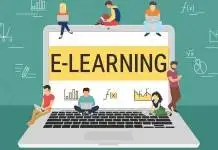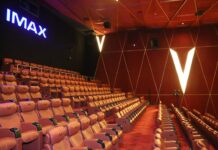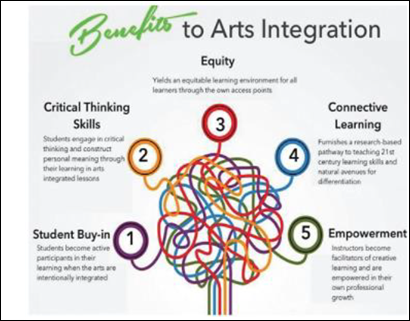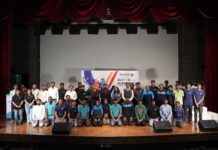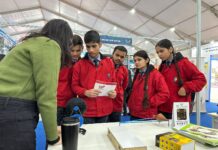- Vagish Jha, Academic Lead and Head of Teacher Training, Schoolnet
As we welcome our normal lives keeping the precautions of masks and sanitizers, the schools are also welcoming kids to the new session. With these two years of set back where the students have been exposed to digital content, it would not be justified to teach them with the same old approach of teaching and learning. As a teacher, one will have to set the goal to transform the children of today into enigmatic personalities of tomorrow with insightful and creative minds that are well-prepared for a dynamic future. This would only be possible if we equip our students with the knowledge, creativity of expressions, and the confidence to face the challenges. plan come up with the Integration of Arts in Education
Art is a creative expression of our thoughts. It is a better way to deliver our teaching of various subjects effectively. Can you think of ideas where a teacher can integrate art in the curriculum? This is the area where we can integrate the expression of creativity in the subjects we teach. The arts are composed of visual performing and literary arts and can become an integral part of the teaching learning process. For the school ecosystem, the adoption of an art-integrating curriculum focuses on teaching-learning processes where art forms the basis of classroom learning. Let’s explore the ways in which art can be integrated in the curriculum:
Integration of arts in education
Since each child has been gifted with an amazing mind full of creativity, the school can provide a platform to nurture their inner potential. Nobel Laureate, Rabindranath Tagore, pioneered the idea of the relationship between arts and learning. Many of his thoughts are captured in a book titled ‘Art: The Basis of Education’ written by his student Devi Prasad (1998). Even at that time, research had found that teaching-learning processes mediated by the medium of arts develops the creativity and critical ability of the learners. Art Integration Learning is a framework which is based on the concept of Experiential Learning. It helps the learners to use at their own convenience and comfort, ways to integrate hands-on activities and provides an equitable learning environment.
There are different types of learners and to satisfy their needs is important to use the various types of creative arts to deliver a lesson. This is the need of the hour. Teachers cannot apply the same old teaching methods to all the types of students. Integrating arts in education certainly helps to cater the needs of all learners.
It helps in
- Building critical integration
- Improving inner motivation
- Involving students
- Leading to creativity
- Nurturing self-expression
- Providing the platform to empower teachers and students
- Providing connective learning
- Bringing out the hidden talent of the students
- Holistic development
CBSE has provided a comprehensive document “Art Integrated Learning – Guidelines” which provides a path to all the stakeholders of school education for Art Integrated Learning as a pedagogy and its innate relevance to the education system. Art Integrated Learning (AIL) is a teaching-learning model which is based on learning ‘through the arts’ and ‘with the arts’. It is a process where art becomes the medium of teaching-learning, a key to understanding concepts within any subject of the curriculum. Learners explore creatively while building connections between different concepts through various art forms. Art experiences, both in visual (drawing and painting, clay modelling, pottery, paper crafts, mask and puppet making, heritage crafts etc.) and performing arts (music, dance, theatre, puppetry etc.) lead to a better understanding and construction of knowledge about different concepts. Arts have the flexibility to accommodate age-appropriate opportunities for learners who can explore these things at their individual pace. This resonates with the experiential learning approach.
Art for skill development
The art integration plays a pivotal role when it comes to skill development. When any subject is taught via the medium of art, be it visual or a performance, it always leaves an impeccable impact on the child’s mind. Art encourages the students to use their mental imagery and thought process and critical thinking in such a way that they can apply their knowledge and solve their problem skillfully. This further leads to holistic development of the child. The integration of expressions in any of the subjects can make the development of the child holistic. This helps the child to go beyond the text, keeping the mind engaged in constructive thinking and to explore what they have learnt during conceptual learning. Learning through arts focuses on nurturing the cognitive development (thinking, recalling and reflecting) and the development of affective (social and emotional) and psychomotor (use of body and movement) abilities of the learner. This leads to holistic development of the child.
ALSO READ: Use of Growth Hormone in Prader – Willi Syndrome
Experiential Learning through Art:
There is a recent emphasis of NCERT to integrate art in the teaching-learning processes. The objective of any art is basically to promote experiential learning. If the teacher explains a lesson, discusses the questions and answers and provides practice worksheets only, it will not be sufficient to develop a deeper understanding of the concept. In this case, the objective would be on how to score good marks rather than making students understand the concept and apply it in real life situations. To widen the horizon with regard to pedagogy, we need to change our classroom into laboratories, and in these laboratories, kids can experience the concepts that have been taught in their classrooms. There is a scope of integrating arts in every subject and we need to give our students a hands-on experience to reap its benefits. For instance, a drama/ role play activity could be played while teaching poems. Similarly, in mathematics, word problems could be solved by creating a simulated environment in the classroom. CBSE has presented a document “Art Integration – towards Experiential Learning” which contains details on the importance of arts, arts as a pedagogical tool for experiential and joyful learning. This document will give recommendations to schools for adopting and adapting arts in all forms and as an integral part of the teaching learning process.
Art in Teaching and Learning Process:
Integrating art in the teaching learning process relates the cross curricular processes of educating the students. The teaching of core academic subjects must not be fragmented but should be related. In this case, teachers can learn a lot if they go for collaborative teaching or co-teaching where they relate the subjects to arts and enable the students to check its connectivity in all spheres of the curriculum. The integration of arts not only makes the teaching learning joyful but also puts a positive impact on the development of certain life skills such as communication skills, reflection and enquiry skills, unconditioning of the mind leading to higher confidence level and self-esteem, appreciation of aesthetics and creativity, etc. Last but not the least, this kind of integration broadens the mind of the students and enables them to see the multidisciplinary links between subjects, and their real life.
Visit EasyShiksha for Education related enquiry













